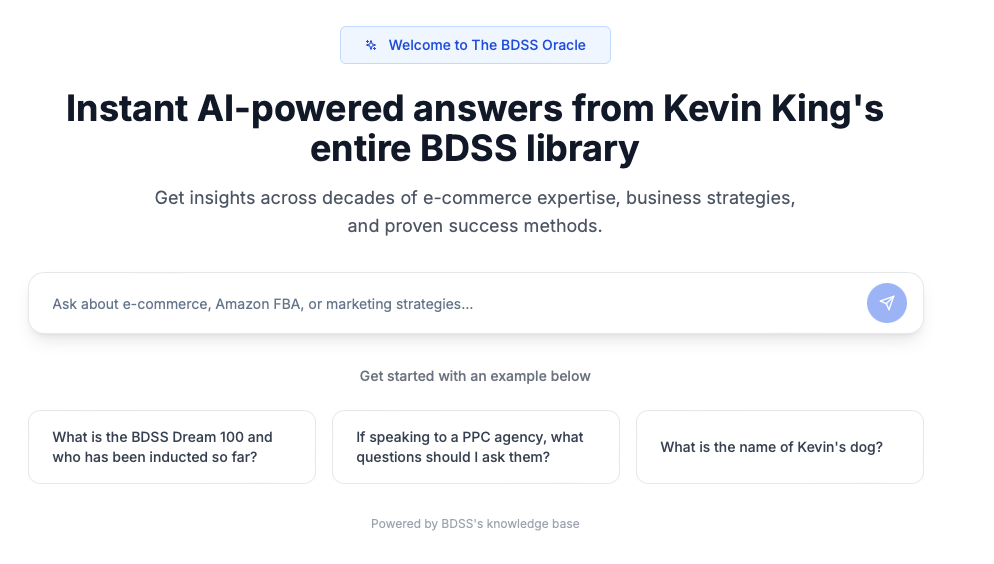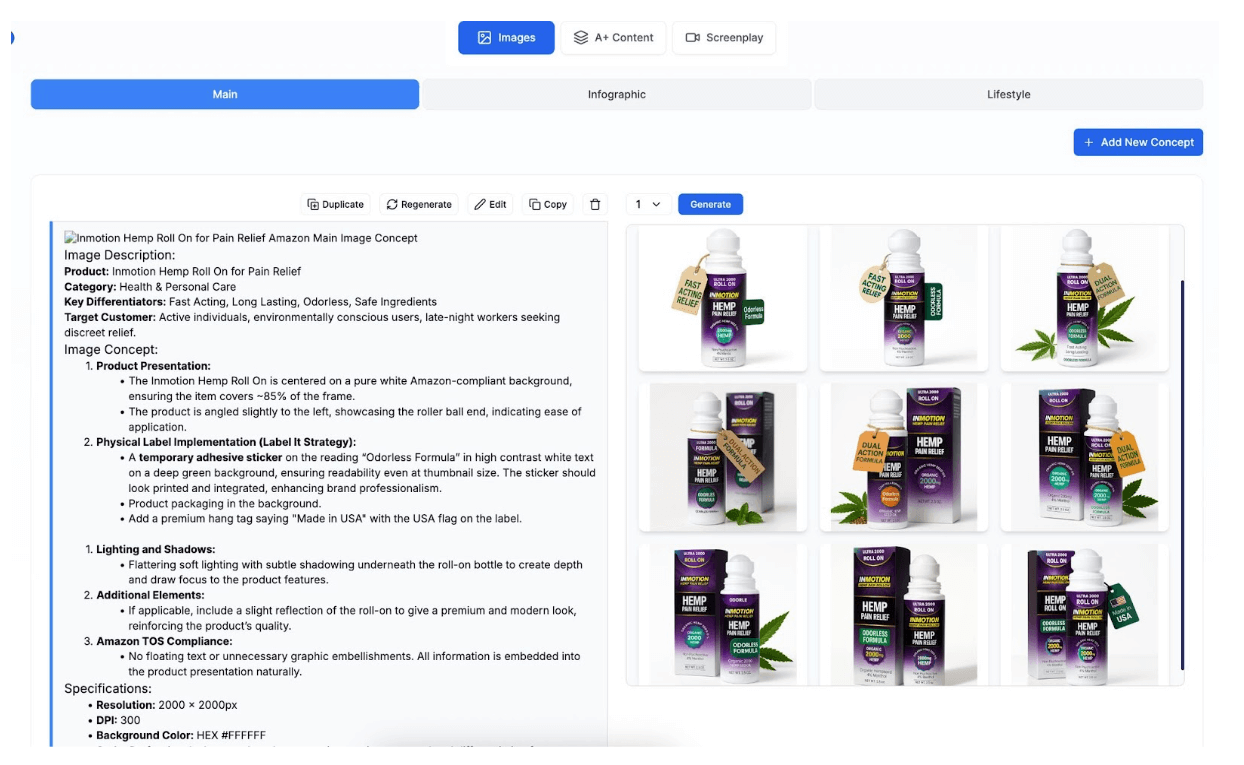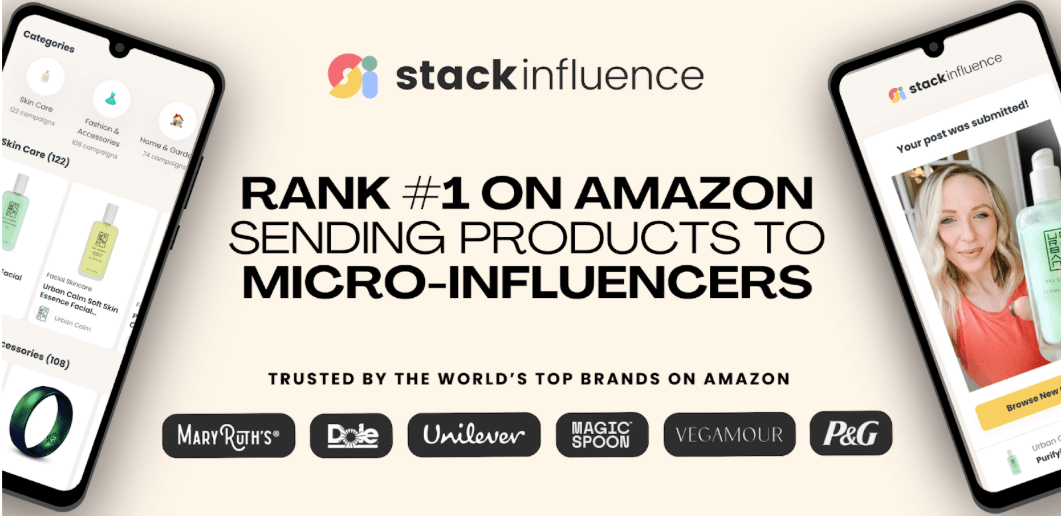- Billion Dollar Sellers
- Posts
- [ BDSN ] How fake Amazon reviews actually work
[ BDSN ] How fake Amazon reviews actually work

 | STUMP BEZOSA recent MIT study found that many companies are getting “zero return” from their AI investments. What percentage say they get no return? [ Answer at bottom of email ] |

💰 INTRODUCING the BDSS ORACLE
When you turn to ChatGPT for help with your Amazon or ecom business, you'll often get useful information. But here's the problem: it can't distinguish between legitimate experts and self-proclaimed "gurus" spreading misinformation on YouTube or blog posts.
ChatGPT treats everything it reads as equally valid, even when it's flat-out wrong.
Here's a real example: Ask ChatGPT about Amazon's "A10 algorithm," and it'll tell you it's the successor to the A9 algorithm. That's completely false. Some people use "A10" as clickbait, but there's no such thing.
Ask the same question to the new BDSS Oracle, and you'll get the truth: "There is no official A10 algorithm for Amazon."
What makes the BDSS Oracle different?
The BDSS Oracle uses content exclusively from Kevin’s curated Amazon and ecom experts, not random internet sources.
It pulls answers only from:
Reputable podcasts for ecom sellers, including Kevin & Norm’s Marketing Misfits
The BDSN Newsletter back to the original
Kevin's webinars and courses
The BDSS WhatsApp Group chats
BDSS events, like BDSS Iceland and the recent BDSS 12 Virtual.
Presentations inside BDSC, like Dan Kurt’s AI ranking hacks
It's completely walled off from all the noise and misinformation flooding the internet, giving you access to exclusive tactics and strategies you won't find anywhere else.
Normally, the BDSS Oracle is restricted to members of the Billion Dollar Sellers Club (BDSC). But for a limited time, Kevin is opening it to the public so you can experience the difference firsthand.
Try the BDSS Oracle today and reply to this email to let me know what you think!

🌎 INTERESTING STATS
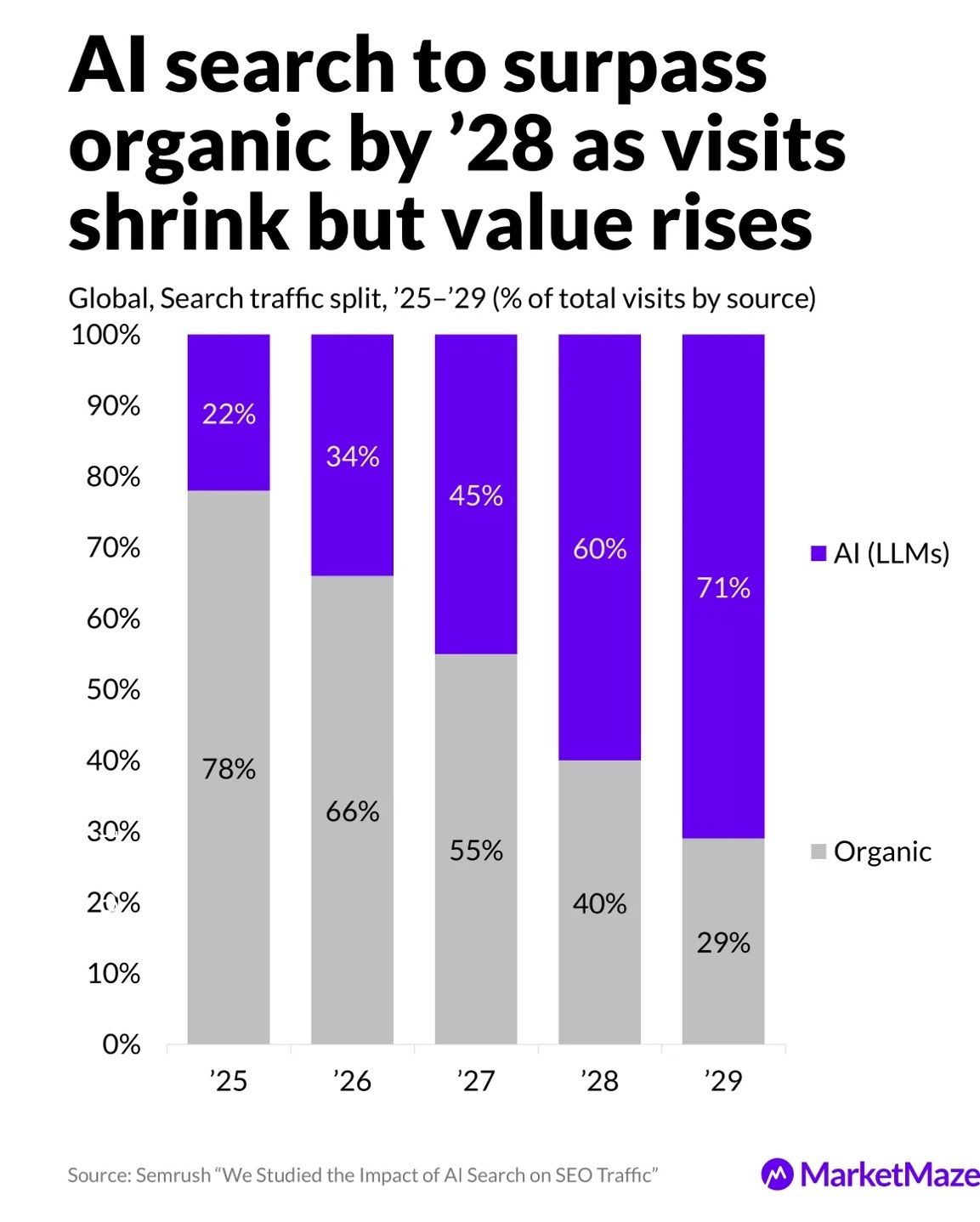

🕹️ AMAZON’S NEW PARTIAL REFUND: YOUR Q4 GAME PLAN
Last week, on October 1, Amazon rolled out expanded FBA partial refunds without returns, letting you refund customers while they keep the item.
The Q4 upside:
Lower costs: Holiday returns are expensive. Eliminating return shipping and processing protects your bottom line.
Less operational strain: Your team is already stretched thin. Fewer return shipments = fewer hours burned.
Faster resolution: Instant refunds keep customers happy during the busiest shopping season.
Revenue protection: Quick, frictionless fixes can salvage customer relationships and drive repeat orders post-holidays.
Sounds promising. But there's a catch.
The risks you can't ignore:
Refund abuse: Some buyers will exploit this, claim issues, keep products, pocket refunds.
Death by a thousand cuts: Even $5–$10 partial refunds add up fast across thousands of orders. Your logistics savings could evaporate.
Blind spots in quality control: No returned items = no physical evidence of defects. You're flying blind on product issues.
Shifting expectations: Once customers learn they can keep items and get refunded, there's no going back. Removing this option later risks backlash.
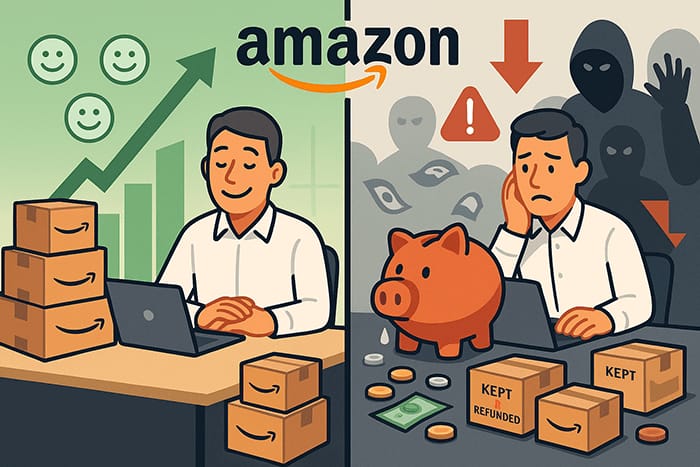
How to use partial refunds without getting burned:
1. Test on low-value, high-volume items first
Start with products under $20 where return shipping exceeds item value. The economics work here.
2. Protect your premium SKUs
Don't enable this for high-value items or categories prone to abuse—electronics, supplements, premium beauty. Brand reputation matters.
3. Cap your refund amounts
Set partial refunds at 15–20% of order value. High enough to resolve complaints, low enough to discourage gaming.
4. Track repeat offenders
Use Amazon's return reports and your CRM to flag serial refund seekers. Patterns emerge quickly.
5. Guard your metrics
Partial refunds still count as returns. Monitor SKU-level return rates religiously. You don't want the "frequently returned" label tanking your listings.
6. Reassess in January
After Q4 wraps, run the numbers. Did partial refunds save money or bleed margin? Keep what works, kill what doesn't.

A brand new AI-powered Amazon
image generation tool has arrived
Be among the first to join Listing Optimization AI
Create main, lifestyle & infographics in minutes, not weeks
80+ proven templates, fully branded & Amazon-compliant
Data-driven designs built to increase CTR & conversions
Market intelligence from actual reviews
Built for creative directors of brands/agencies
Join today - 50 images per month complementary

🔗 BDSN MYSTERY LINK of the DAY 🔗

🙊 INSIDE the WORLD of FAKE AMAZON REVIEWS
An Ecom Crew investigation went undercover into Amazon's fake review networks.
What they found was a sophisticated operation that Amazon's lawsuits haven't stopped.
How It Actually Works
Facebook is the marketplace. Dozens of region-specific groups (US, Canada, UK, password-protected VIP groups) connect sellers with reviewers. The process: customer buys product at full price, leaves review, gets PayPal refund, keeps free product. The investigator tested it, got a free webcam and confirmed the system works perfectly.
Professional operations charge $5 per review plus product cost. They primarily target Chinese sellers and require WeChat video verification. One seller provided a tracking dashboard showing real-time order status, customer IDs, and review posting (delayed 7 days to look organic).
The Amazon Lawsuit That Changed Nothing
The investigator discovered Amazon had "shut down" the exact website they bought from, except it hadn't. Court records showed defendants simply never responded to the lawsuit. Amazon won by default, issued a victory press release, while the website kept operating and taking orders.
The Scale
The upsell revealed everything: 100 five-star reviews in 30-40 days. Competitor sabotage with one-star reviews? Also available. The typical reviewer isn't a criminal, she's a local teacher and mother leaving dozens of overly enthusiastic reviews for free products, unknowingly violating FTC rules.
Amazon says they stopped millions of fake reviews in 2024 alone. That's not a solution—that's the scope of the problem.
Your competitors know about these systems. Some are using them. Meanwhile, buyer distrust affects everyone's conversion rates.
Watch the full Ecom Crew investigation to see the WeChat call footage, live dashboard screenshots, and reviewer profiles. This isn't happening in the shadows, it's happening on your listings right now.

Reach page 1 on Amazon simply by sending free products to Micro-Influencers
Use the platform Stack Influence to automate Micro-Influencer product seeding collaborations at scale (get thousands of collabs per month) and increase your Amazon ranking, generate UGC, and boost up your recurring revenue like never before.
Top Amazon brands like Magic Spoon, Unilever, and MaryRuth Organics have been able to get to #1 page positioning on Amazon and increase their monthly revenue as high as 13X in as little as 2 months.
Pay influencers only with products (stop negotiating fees)
Increase external traffic Amazon sales (get to top page rankings)
Get full rights image/video UGC (build your brand with authentic content)
100% automated management (don’t lift a finger to get influencer collabs at scale)
Don't believe it? Check out the results from the Blueland Micro Influencer campaign which generated a 13X ROI scaling up influencers on Amazon.
After successfully raising investment on Shark Tank, Blueland turned to Stack Influence to boost their Amazon sales and become a top selling listing using Micro Influencer marketing.
Increase your Amazon listings ranking for targeted keywords and multiply your organic recurring revenue in 2025!
Get 10% OFF by signing up this month

🗜️ OPEN AI’S SORA 2: The MISSING COMMERCE PIECE
In a recent edition of her AI for E-commerce newsletter, Jo Lambadjieva breaks down why OpenAI's Sora 2 launch, which came just days after ChatGPT added native checkout, is actually a brilliant commerce play disguised as a TikTok clone.
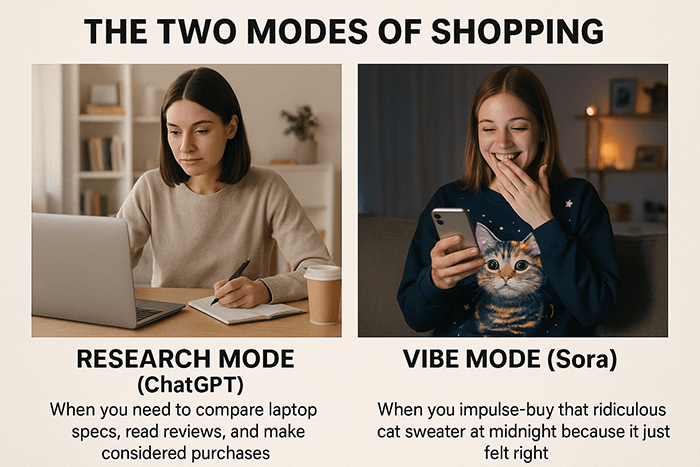
The Two Modes of Shopping
Jo's key insight: We shop in fundamentally different modes depending on what we're buying.
Research Mode (ChatGPT): When you need to compare laptop specs, read reviews, and make considered purchases
Vibe Mode (Sora): When you impulse-buy that ridiculous cat sweater at midnight because it just felt right
ChatGPT dominates Research Mode but completely fails at Vibe Mode—those visual, emotional, "I didn't know I needed this" moments that drive billions in sales on TikTok Shop.
Closing the Loop
Now OpenAI has both pieces: the analytical research assistant AND the entertainment-driven discovery engine. More importantly, they control the entire journey: discovery happens in Sora's feed, and transactions happen through ChatGPT's checkout. It's a closed ecosystem that guides every type of purchase, from considered to impulsive.
For e-commerce sellers, Jo warns: static product photos are about to feel as outdated as GeoCities websites. The future demands dynamic, AI-generated content that works across this new discovery-to-purchase ecosystem.

Like BDSN? Forward this email to a friend!
If you’re that smart friend, subscribe now:

📛 MASSIVE KEEPA UPDATE JUST DROPPED
Saul (@Saul) on X:
Amazon Sellers, massive Keepa update just dropped 🚨
Keepa quietly rolled out some new features, and this one's a game-changer. It's like storefront stalking on steroids.
You can now view the ENTIRE historical product catalog of any Amazon seller using just their seller ID.

Why does this matter?
When you're sourcing replenishments, seasonal items, or arbitrage products, you'll notice the same sellers popping up on your listings.
Before, you could only check their current inventory. Now? You can dig into their out-of-stock items - the ones they'll be restocking soon.
Found a seller hitting all your same retail stores? Check what they crushed with last holiday season and track those products down for yourself this year.
Doing wholesale? You just got handed your competitors' entire catalog to reverse-engineer their distributor relationships.
Want to test it? Go to Keepa > Data > Product Finder and look for the section shown in the screenshot above.

🔥 MORE HOT PICKS 🔥
🥃 PARTING SHOT
“Life is about the experiences you have and the people you meet.”
✌🏼 See you again Thursday …
The answer to today’s STUMP BEZOS is
95% say they get no return from investing in AI
